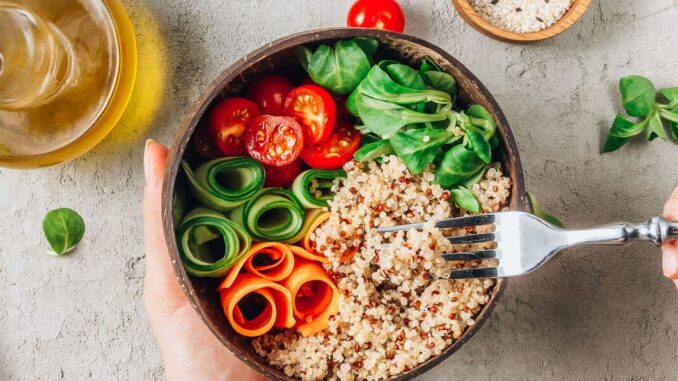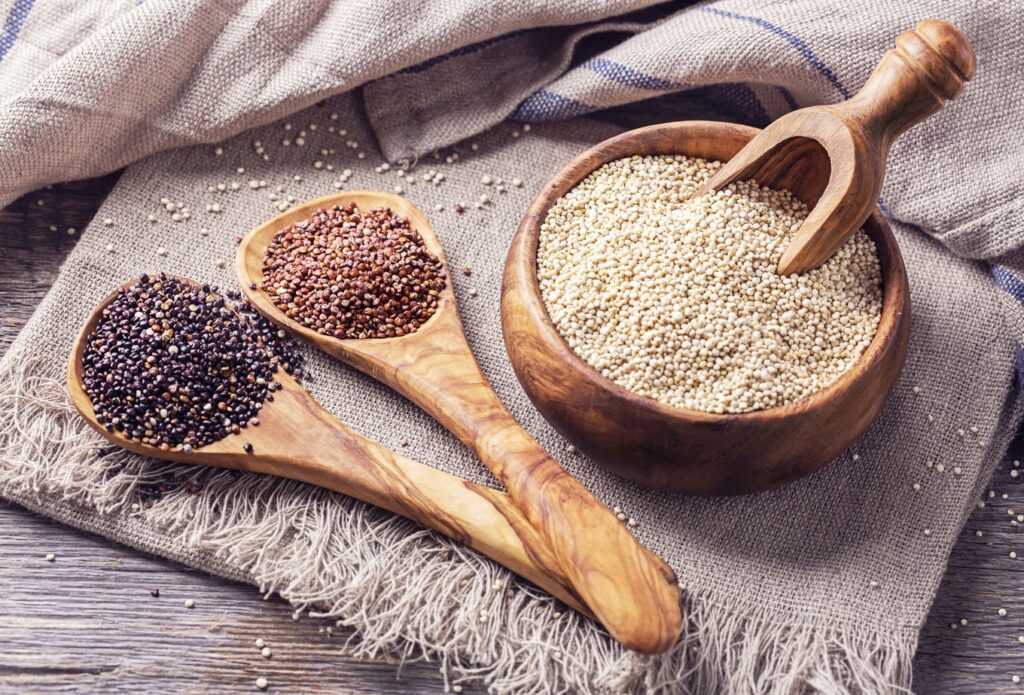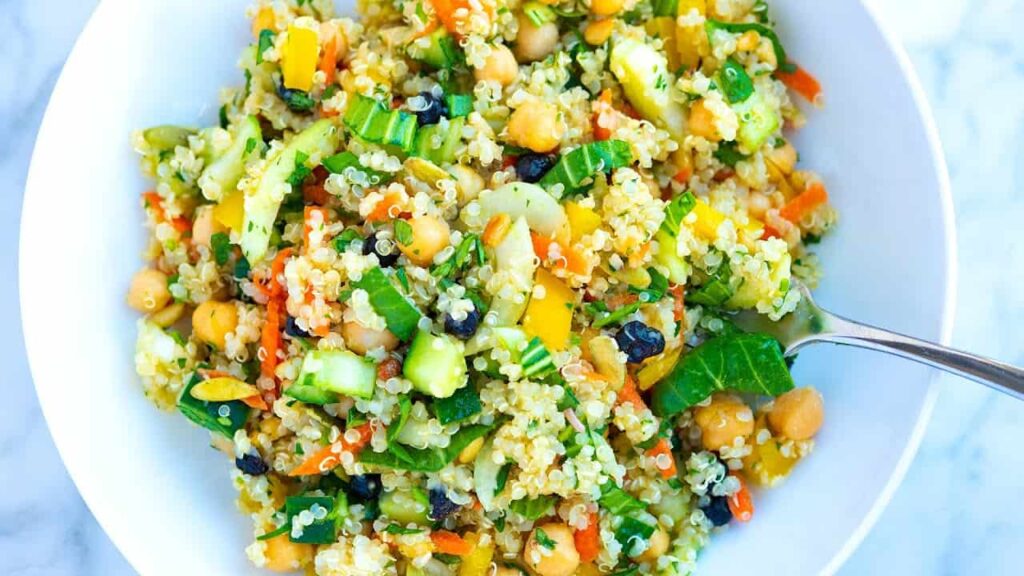
Whether you’re planning to use quinoa in a vibrant salad, a hearty grain bowl, or as a side dish, the fluffiness of your quinoa can make or break the dish. If you don’t know how to cook quinoa the right way, it can turn out mushy or undercooked, and disappointing.
But when the quinoa is cooked perfectly fluffy, it’s like a symphony of flavors and textures in your mouth. Each grain is distinct, with that delightful nuttiness coming through.
Here are our best tips and techniques for cooking quinoa like a pro!
1. Choosing the Right Quinoa

Quinoa comes in various colors, including white, red, and black.
While the color doesn’t always determine quality, it’s essential to select the color that suits your recipe. White quinoa is the most common and has a mild flavor, while red and black quinoa have a slightly nuttier taste and can add visual appeal to your dishes.
Selecting high-quality quinoa that serves as the foundation for achieving that perfect, fluffy texture in your dishes. Remember that the quality of your ingredients can significantly impact the final result of your quinoa recipes.
Look for trusted brands or sources with a reputation for quality. High-quality quinoa is often sold in well-sealed, airtight packages that protect it from moisture and pests.
2. Rinsing Quinoa Before Cooking
Quinoa is naturally coated with a bitter substance called saponin, which acts as a natural defense mechanism for the plant. To ensure that your quinoa is not overly bitter, it’s advisable to rinse it before cooking.
Here’s how to rinse quinoa before cooking:
- Place the quinoa in a fine-mesh strainer.
- Rinse it under cold running water for a minute or so, using your fingers to agitate the grains gently.
- Continue rinsing until the water runs clear.
Rinsing not only removes the saponin but also any remaining impurities, resulting in cleaner, better-tasting quinoa. It’s a simple step that can significantly improve the flavor of your final dish.
Is quinoa soaked before cooking? How long to soak quinoa? What happens if you don’t soak quinoa?
Soaking quinoa is not a common practice and is generally unnecessary. Quinoa doesn’t require soaking before cooking, like rice or legumes. However, rinsing quinoa is recommended to remove its natural bitter coating called saponin.
After rinsing, you can cook quinoa directly, and it will typically be ready in about 15-20 minutes, depending on the cooking method and the type of quinoa you’re using (white, red, or black).
3. The Perfect Water-to-Quinoa Ratio
Achieving the right water-to-quinoa ratio is a key factor in cooking perfect and fluffy quinoa.
What is the ratio of water to quinoa?
For most types of quinoa (white, red, or black), use a ratio of 2 parts liquid to 1 part quinoa.
The 2:1 ratio ensures that the quinoa absorbs enough liquid to become tender and fluffy without becoming mushy or dry. Keep in mind that this ratio is a starting point, and slight adjustments may be needed based on your preferences and cooking conditions.
How much water do I need for 1 cup of dry quinoa?
If you’re cooking 1 cup of quinoa, you’ll need 2 cups of liquid.
Water is the most common choice, but you can also use vegetable broth or chicken broth for added flavor.
4. Cook Quinoa: Techniques for Perfect & Fluffy Quinoa
Wondering how to cook quinoa like a chef?
Cooking quinoa is a straightforward process. Just follow these simple instructions to get perfectly cooked quinoa.
Step-by-Step Instructions for Cooking Quinoa
1. Rinse the Quinoa: Place the quinoa in a fine-mesh strainer and rinse it under cold running water for about a minute to remove the natural bitter coating, saponin.
2. Combine Quinoa and Liquid: In a saucepan, combine the rinsed quinoa and the appropriate amount of water or broth following the 2:1 ratio (2 cups of liquid for 1 cup of quinoa).
3. Bring to a Boil: Place the saucepan over medium-high heat and bring the quinoa and liquid to a boil.
4. Simmer: Once it boils, reduce the heat to low, cover the saucepan with a lid, and let it simmer for about 15-20 minutes. Check for the appearance of tiny, white, spiral-shaped germ rings around the grains to ensure it’s done.
5. Let It Rest: After cooking, remove the saucepan from the heat, but keep the lid on. Let the quinoa rest for a few minutes. This allows it to absorb any remaining moisture and become fluffier.
6. Fluff and Serve: Finally, fluff the quinoa with a fork and serve it as desired. It’s ready to be incorporated into a variety of dishes.
5. The Importance of Letting Quinoa Rest After Cooking
Allowing quinoa to rest after cooking is a crucial step in achieving the perfect texture.
How do you remove moisture from quinoa? Is quinoa supposed to absorb all the water? Why is my quinoa soggy and not fluffy?
During this resting period, the quinoa continues to absorb any remaining moisture, and its grains separate, making it fluffy and delightful to the palate. Skipping this step can result in a wet, soggy, or clumpy texture, which is not what we want.
Ideally, let the quinoa rest for about 5-10 minutes after cooking. Keep the lid on the pot during this time. This simple step makes a significant difference in the quality of your quinoa, so be patient and enjoy the rewards of perfectly cooked quinoa in your dishes.
6. How to Fluff Cooked Quinoa for the Perfect Texture
Fluffing quinoa is the final touch that ensures its perfect texture.
How do you keep quinoa fluffy? Here’s how to do it:
- Take a fork and gently insert it into the cooked quinoa.
- Use a gentle, fluffing motion to separate the grains. The fork helps to break up any clumps and keep the grains separate.
- Continue to fluff the entire batch of quinoa until it has a light, airy texture.
The result should be quinoa with individual, distinct grains and a delightful, fluffy texture, ready to absorb the flavors of your dish.
7. Delicious Ways to Use Cooked Quinoa

Quinoa is incredibly versatile and can be used in various dishes from appetizers to main courses:
1. Quinoa Salads: Use quinoa as a base for vibrant salads by adding fresh vegetables, herbs, and your choice of protein (chicken, shrimp, tofu, or beans). Drizzle with your favorite dressing for a delicious and nutritious meal.
2. Grain Bowls: Create grain bowls with quinoa as the foundation. Top it with grilled or roasted vegetables, protein, and a flavorful sauce or dressing.
3. Stuffed Peppers or Tomatoes: Cook quinoa and mix it with your favorite stuffing ingredients, then use it to fill bell peppers, tomatoes, or other vegetables for a tasty and nutritious dish.
4. Quinoa Soups: Add cooked quinoa to soups or stews for added texture and nutrition. It works well in both broth-based and creamy soups.
5. Quinoa Breakfast Bowls: Make a hearty breakfast by topping cooked quinoa with yogurt, fresh fruit, nuts, and a drizzle of honey.
6. Quinoa Patties: Mix cooked quinoa with vegetables, herbs, and spices to create quinoa patties that can be baked or pan-fried for a delightful appetizer or main course.
Before You Go…
Quinoa is not only a superfood but also a versatile ingredient that can elevate your meals. Whether you’re a seasoned chef or just starting your culinary journey, don’t hesitate to experiment with quinoa. Try it in salads, grain bowls, soups, and more. Use it as a canvas for your favorite flavors, seasonings, and ingredients.
By incorporating quinoa into your cooking, you can savor its nutty taste, exceptional texture, and impressive nutritional benefits. So, go ahead, get creative!
Related Topics:
Common Mistakes to Avoid While Cooking Quinoa
Best Ideas for Seasoning and Flavoring Quinoa
Troubleshooting Common Quinoa Issues
How to Cook Quinoa Using Different Cooking Methods
